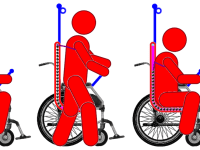This is a device for use by people of advanced age, and patients who are being rehabilitated, who lose (or are liable to lose) their balance while standing up or walking. It consists of a basic wheelchair of the standard type with large wheels which the user may self-operate if possible. It is modified such that when the user gets up, the seat underneath him moves out of the way to enable him (or her, hereinafter) to walk with his hands on the side arms of the wheelchair or a swing-bar in front. If the user wishes to rest out of fatigue or dizziness, or if he collapses during the walking, the mechanism automatically swings back the seat portion of the wheel chair, so that he is never without sufficient support to prevent him crashing to the floor.
The current idea is that the force required to enable the seat portion to swing our of the way during walking and to return to the sitting position will be minimal, and within the capacity of the weakest user, as it would be triggered by the rising and lowering of the user's body. However, improvements have been envisaged for further simplification and data gathering by means of electronics in the process. Apart from the obvious uses in emergency rooms, physio-therapy labs, and accident wards of hospitals, senior citizen homes, etc., the SafeWalker can also be very effective in private homes.
The main advantage of the device is that once the person is seated in the wheelchair, with a single hook-up to the device at the back of the person near his shoulder level, there will be no need for a human nurse or attendant to keep walking along with the user, ready to support him if and when he collapses.
The device is intended to be fail-safe in that if the automatic mechanism should fail to work for any reason, the user will still be held up by his chest harness so that he will be never in any danger of collapsing and getting injured. Although the device will become somewhat more complicated (and hence more expensive and less robust), foldable models are also planned to make the SafeWalker portable in automobiles and other vehicles and in homes.
Manufacturing, especially of the basic mechanical type, is not expected to involve any new or complex technology. The cost, when manufactured in quantity is not estimated to be more than about 50% to 100% higher than current wheel-chairs.
The benefits of the device are predicted to be many times the additional cost, in terms of reduced trauma to and increased confidence by the users, and reduced costs to address the current costs of falls in-place or during walking.
A docking mechanism between the SafeWalker and a standard treadmill is also proposed so that the user may confidently move himself to the treadmill, and with a (possibly assisted) single hook-up of his harness to the treadmill frame, continue to use the exercise device safely.
Like this entry?
-
About the Entrant
- Name:Natarajan Krishnamurthy
- Type of entry:individual
- Software used for this entry:GUI
- Patent status:pending








